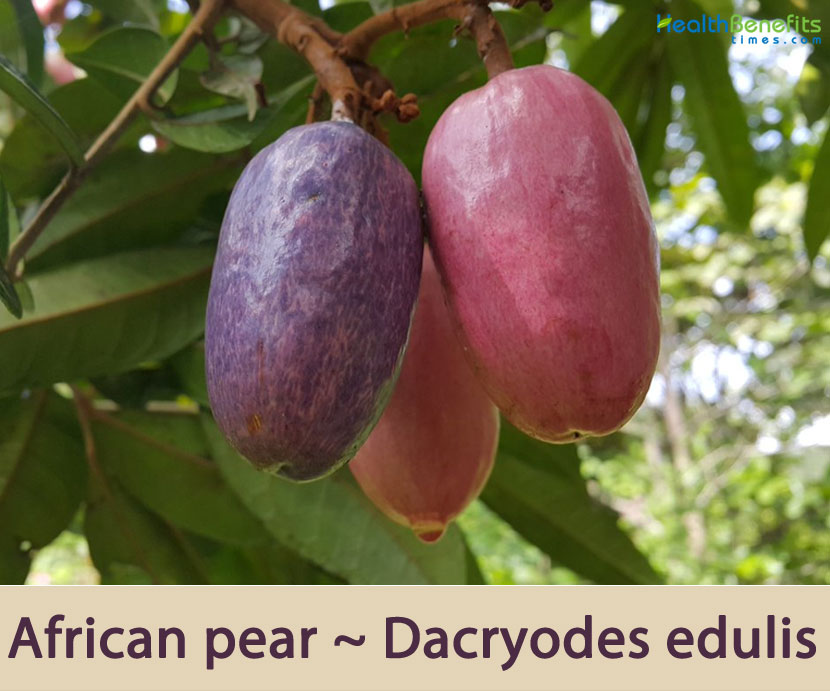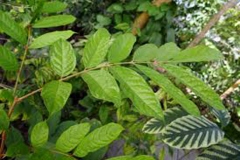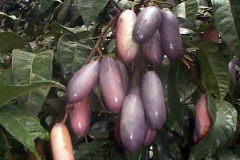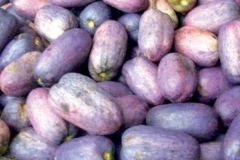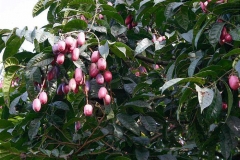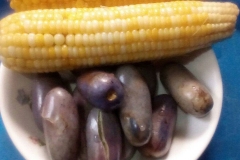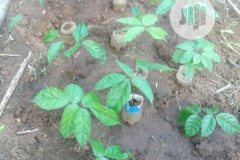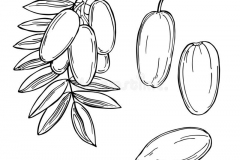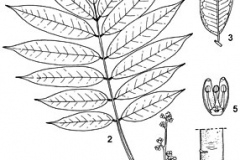The generic name Dacryodes is derived from the Greek word Dakruon meaning tear, referring to resin droplets on the bark surface of its members, while edulis means edible, emphasizing the importance of the nutritious fruit in the plant’s cultivation. There are two variants of Dacryodes edulis: They are Dacryodes edulis var. edulis and Dacryodes edulis var. parvicarpa. The fruit of Dacryodes edulis. var. edulis is larger and the tree has stout, ascending branches. Dacryodes edulis. var. parvicarpa has smaller fruit and slender, drooping branches. African pear is a major fruit crop in parts of Africa, where the tree is widely utilized as a local source of food, medicine and other commodities. It is both harvested from the wild and also often cultivated.
African Pear Facts
| African pear Quick Facts | |
|---|---|
| Name: | African pear |
| Scientific Name: | Dacryodes edulis |
| Origin | Gulf of Guinea and Central African countries |
| Colors | Pink ripening to form blue-green, purple or brilliant black |
| Shapes | Ellipsoid drupe and vary in size, 4-12 cm long and 3-6 cm wide, resembling olives |
| Flesh colors | Pale to light green |
| Taste | Mild, slightly tangy |
| Health benefits | Promotes Digestive Health, Prevents Diarrhea, Prevents Cancer, Prevents Diabetes, Promotes Healthy Bones and Teeth, Lowers High Blood Pressure, Promotes Skin Health, Promotes Healthy Oral Health, Boosts Immune System, Reduces constipation, Reduces Age-Related Diseases, Good for Pregnancy, Prevention of Skin Irritation, Helps to lose weight, Increases mood, Relieves pain, Treat eye problems |
| Name | African pear |
|---|---|
| Scientific Name | Dacryodes edulis |
| Native | Gulf of Guinea and widely cultivated in other tropical parts of Central African countries. The natural range extends from Angola in the South, Nigeria and Sierra Leone in the West and Uganda in the East. It is also cultivated in Malaysia. |
| Common Names | Bush Butter Tree, Butterfruit, African Plum, bush pear, bush plum, safou, Native pear, African pear, Ajong, Elemi, Ube mbu, Safu, African pear tree, Bush butter, Bush fruit tree, Eben tree, atanga, ube and nsafu |
| Name in Other Languages | Benin: Omunu Cameroon: Kpe bo-sau Catalan: Atanga Chinese: Shíyòng làzhú shù (食用蜡烛树) Congo Democratic Republic: Nsafou Côte d’Ivoire: Abe vi, akye tsai, anyi karenda English: African pear, African pear tree, African plum, African plum tree, Bush butter, Bush butter tree, Butter fruit tree, Eben tree, Native pear, Omunu French: Atanga, Eyomédiomé, Safou, Safoutier, Prunier du Gabon Gabon: Atanga German: Saphubaum, Afrikanische Pflaume Japanese: Dakuriodezu edeurisu (ダクリオデス・エデウリス) Konga: Nsafu, Nsafu zankewa Lingala: Bofwole, Sáfú Nigeria: Abua Portuguese: Safu Russian: Dakriodes s”yedobnyy (Дакриодес съедобный) Spanish : Uva del país Yoruba: Elemi Others: Abe vi, Abua, Adzom, Akye tsai, Anyi karenda, Asa minegou, Assas, Atanga, Bosáo, Bosaw, Boshu, Dibanga, Diganga, Eben, Essesia, Ibagho, Ifoele, Kisafou, Mobafu, Nsafu zankewa, Ollem, Orumu, Ube mbu, Ube nkputaki, Safu, Igaganga, Elem, Osoan |
| Plant Growth Habit | Medium-sized, dioecious, shade loving, evergreen tree |
| Growing Climates | Swamp forest, Evergreen forest, gallery forest and on swampy ground, shady, humid tropical forest |
| Plant Size | About 18-40 m but not more than 12 m in plantations and 50-170 cm in diameter |
| Bark | Bark yellowish- grey to grey, often shallowly scaly and with lenticels and horizontal folds, slash brownish-pink, exuding drops of translucent-whitish, aromatic resin |
| Leaf | Alternate, compound, and imparipinnate, with 5-8 pairs of leaflets. They are glossy and pubescent, the pubescence disappearing with age |
| Flowering season | January to April |
| Flower | Flowers are fragrant, about 5 mm across and are trimerous except for the ovary. They are arranged in dense, ferruginous, stellate-tomentose inflorescence |
| Fruit Shape & Size | Ellipsoid drupe and vary in size, 4-12 cm long and 3-6 cm wide, resembling olives |
| Fruit Color | Pink ripening to form blue-green, purple or brilliant black |
| Flesh Color | Pale to light green |
| Seed | Oblong- ellipsoid, up to 5.5 cm long |
| Propagation | By seed |
| Taste | Mild, slightly tangy |
| Plant Parts Used | Fruits, flowers, bark and leaves |
| Varieties |
|
| Season | May and October |
| Health Benefits |
|
| Culinary Uses |
|
Plant Description
African pear is a dioecious, medium-sized, shade loving, evergreen tree that normally grows about 18-40 m but not more than 12 m in plantations and 50-170 cm in diameter. It is generally branched from low down, with a deep, dense crown. The bole is rather short, slightly fluted, 50-170 cm in diameter and more or less sinuous. The scented bark is yellowish- grey to grey, often shallowly scaly and with lenticels and horizontal folds, slash brownish-pink, exuding drops of translucent-whitish, aromatic resin. Buttresses are absent. The plant is found growing in swamp forest, evergreen forest, and gallery forest and on swampy ground, shady, humid tropical forest.
Leaves
Leaves are alternate, compound, and imparipinnate, with 5-8 pairs of leaflets. They are glossy and pubescent, the pubescence disappearing with age. They are oblong-lanceolate or ovate-lanceolate, up to 20 -30 cm long and 6 -8 cm wide, broadly cunaete to rounded and asymmetric at base. They are acuminate at apex and margin is entire and glabrescent. Petiole is up to 7.5 cm long. The upper surface of the leaves is glossy.
Flowers
Flowers are unisexual, subtended, 3 lobed and conspicuous with caducous low bract. Flowers are fragrant, about 5 mm across and are trimerous except for the ovary. They are arranged in dense, ferruginous, stellate-tomentose inflorescence. Sepals and petals are 3, the former showing brown color and the latter, cream color. Stamens are 6 and are slightly shorter than petals. Disc is also 6 but lobed, surrounding the two-celled, glabrous ovary. Styles are very short and stigma is 2-4 lobed. Inflorescence axis is 10-42 cm long or may be longer and deeply grooved. Flowering normally takes place in between January to April.
Fruit
Fruits are ellipsoid drupe and vary in size, 4-12 cm long and 3-6 cm wide, resembling olives. The exocarp is thin and pink ripening to form blue-green, purple or brilliant black. The fruits are one-seeded, with pulpy pericarp, about 5 mm thick and thin, cartilaginous endocarp. Seeds are oblong-ellipsoid, up to 5.5 cm long. The cotyledons are very much thickened and deeply folded or conduplicate, appearing palmately lobed. The tree flowers at the beginning of the rainy season and bears fruits during 2 to 5 months after flowering.
Medicinal uses of African pear (Dacryodes edulis)
Uses |
Parts Used and Preparation |
| Ectoparasite infection, skin diseases & disorders |
|
| Skin smoothening (lotion) |
|
| Skin abrasions, cuts, scratches, & wounds |
|
| Toothache, gum problem, gargle, mouthwash, tonsillitis, mumps |
|
| Malaria/high fever |
|
| Arthritis, muscle pain/stiffness (e.g., cramps), inflammation, muscle relaxation |
|
| Earaches |
|
| Stomach disorder, constipation, digestive tract discomfort, indigestion, heartburn |
|
| Dysentery & anemia |
|
| Beri beri, rickets, & ulcers |
|
| Emesis: Vomiting & nausea |
|
| Ease labor pains, safe delivery, menstruation |
|
| Stress, internal body heat, etc. |
|
| Hypertension |
|
| Retarded growth in children |
|
| Insomnia & cough |
|
| Leprosy |
|
| Diabetes/blood sugar |
|
Health benefits of African pear
Listed below are some of the well-known health benefits of African Pear
1. Promotes Digestive Health
Consuming African pear helps to stimulate the digestion. It promotes the proper digestion and nutrient assimilation. As we all know that the process of nutrient absorption happens in the digestion system. As a result, it builds the connection between what we eat and how good and healthy our digestion system is. Besides, fiber in African pear has pectin, cellulose, and lignin that resist the action of the digestive enzyme. Consume African pear from now on as it will help to promote digestion and prevent the presence of constipation as well.
2. Prevents Diarrhea
As explained before, African pear consists of the fiber in it. In this case, fiber has Pectin that helps to control diarrhea and binds substance in the intestine. Thus, you can count on African pear to help you dealing with diarrhea for sure.
3. Prevents Cancer
Surprisingly, African pear can give the health benefits to prevent cancer. This is due to the presence of antioxidants that help to fight free radicals and diseases in the human body. At this point, it is recommended to eat antioxidant foods such as fruits and vegetables to have the healthier body and preventing cancer as well.
4. Prevents Diabetes
As We all know that diabetes is a chronic disease. To deal with this, we need a right treatment and prevention. In this case, diabetes has vitamins and minerals that play important roles in controlling the blood sugar level. Not only for that, but the low glycemic index carbohydrate in it also helps to digest and metabolize the body and lower the blood glucose levels.
5. Promotes Healthy Bones and Teeth
Due to the presence of calcium and phosphorus in African pear, then it will be beneficial to promote healthy teeth and bones. Indeed, these minerals play a major role in maintaining bone health, muscle contraction immune system and blood clotting. Thus, make sure you consume dairy foods and African pear to have such strong bones and teeth.
6. Lowers High Blood Pressure
Consuming African pear helps to lower the high blood pressure. It is due to the presence of potassium in it. This will be resulting in the lowering level of blood pressure. As the consequence, it can encourage heart health and prevent the risks of stroke. To get this benefit, you can eat 5 portions of fruit per day.
7. Promotes Skin Health
African pear helps in promoting the skin health. This is due to the presence of antioxidants and vitamin C and riboflavin to keep the skin glowing. Not only for that, it is rich in oil that can treat skin diseases such as ringworm, craw-craw, and related others.
8. Promotes Healthy Oral Health
Nigerian pear consists of a great amount of antimicrobial properties, and for this reason, it is being used in making toothpaste in certain parts of Africa. Multiple local studies reveal that these potent properties also play a major role in combating the bacteria, which often causes mouth odor and tooth decay.
Therefore, if you are looking for a natural way to handle either of the two mouth conditions, it is suggested you increase your pear fruit intake to quicken the recovery.
9. Boosts Immune System
Bush pears help to improve immunity due to the presence of vitamin C which helps the immune system to resist certain diseases and also maintain a healthy immunity. Immune boosting property in African bush pear comes from vitamin C and essential minerals that act as antioxidants that help to strengthen immunity and improve the infection-fighting ability of the immune systems.
10. Reduces constipation
Soluble fiber content on bush pear is a good property that gives it the ability to reduce constipation, aid to a normal bowel movement. This fiber consists of pectin, cellulose, and lignin that resist the action of the digestive enzyme. Pectin helps to control diarrhea and binds substance in the intestine.
11. Reduces Age-Related Diseases
Studies have shown that regular consumption of this fruit slows the risk of macular degeneration in aged people. African pears exhibit strong antioxidants properties that help to prevent some age-related illness which causes poor vision.
12. Good for Pregnancy
You may be surprised to hear that African pear is a pregnancy super fruit. It consists of natural folic acid which is considered good in pregnancy. The presence of folic acid in African pears helps to prevent deficiencies in baby’s brain and spinal cord. African pear is rich in sugars, carbohydrates, fiber, foliate, pantothenate and vitamins such as vitamin B6, thiamine, niacin, riboflavin, the antioxidant vitamin (vitamin C) which helps to fight the free radicals in the body.
13. Prevention of Skin Irritation
The oxidative stability of the African pear oil has the potentials of preventing skin irritation. The oxidation ability of the African pear oil makes it suitable for use as a body cream. The exudates from African pear consist of antibacterial agent and if added in creams help to stabilize emulsion. The oil is very smooth on the skin and protects the skin from dryness.
14. Helps to lose weight
The benefit of African pear to lose weight is related to the nutrient called as soluble fiber. The fiber makes stomach feel full and it prevents you to eat more foods that can lead to lose weight. Since then, the fruit is good for weight loss but for the best result, it is better to do diet treatment as recommendation from the doctor.
15. Increases mood
African pear consists of good amount of Vitamin C and it has been believed to increase mood. It encourages the production of neurotransmitters like norepinephrine, which gives a great impact to the mood of the person. In addition, it also has the benefit for the function of brain.
16. Relieves pain
Some people may not concern about the benefit of African pear to relieve pain. It can speed up the process of recovery of injuries or wounds. The benefit comes along with vitamin C and linked with the boosting of immune system.
17. Treat eye problems
Eye problem such as cataract can be treated with African pear. It is because the condition commonly happens when the lens of human eye is having less of vitamin C.
Traditional uses and benefits of African pear
- Bush butter tree has long been used in traditional medicine to treat wounds, skin ailments, fever, ear trouble, tonsillitis, and dysentery among other conditions.
- Resin from the bark is used to treat parasitic skin diseases, jiggers etc.
- Bark-decoction is taken powdered with maleguetta pepper as an anti-dysenteric, and for anemia, spitting blood and as an emmenagogue.
- Decoction is also used for making gargles and mouth-washes, for treating tonsillitis.
- The pulped-up bark is used as a wound cicatrizant.
- Combined with palm-oil, it is applied topically to relieve general pains and stiffness and to treat cutaneous conditions.
- Leaf-sap is instilled into the ear for ear-trouble.
- It has long been used in the traditional medicine of some African countries to treat various ailments such as wounds, skin diseases, dysentery, and fever.
- Decoction of the bark is taken orally to treat leprosy.
- Leaf sap is used as ear drop to treat ear trouble, while a leaf decoction is prepared to produce vapor that treats fever and headache.
- In Congo Brazzaville, the leaves are boiled with those of Lanata camara, Cymbopogon citratus and Persea Americana in water to form a decoction for treating malaria.
- Steam bath can also be taken from the decoction to treat the same ailment.
- Boiling the leaves with those of P. Americana alone can be used to treat headache, antalgic and cephalgy.
- Leaves are made into plaster to treat snakebite in Southwest Cameroon.
- Bark resin is used in Nigeria to treat parasitic skin diseases and jiggers.
- When applied in lotions and creams, the resin smoothens and protects the skin.
- Aroma of the resin when liberated through burning is believed to ward off evil spirit in Nigeria.
- Leaves are often crushed and the juice released to treat generalized skin diseases such as scabies, ringworm, rash and wound.
- Stem or stem twigs are used as chewing sticks for oral hygiene.
- In Nigeria the resin is used for treating parasitic skin diseases and jiggers.
- Bark decoction is used for gargle and mouthwash and for tonsillitis in Democratic Republic of Congo.
- It is applied topically to relieve general pains and stiffness and to treat cutaneous conditions.
- In the Democratic Republic of Congo, the leaves are eaten raw with kola nut as an anti-emetic.
- Leaf sap is instilled into the ear for ear problems, and a leaf decoction is prepared as a vapor bath for feverish stiffness with headache.
- Eating the fruit, drinking the leaf concoction, or chewing fresh tender leaves helps improve bowel movement and relieves constipation and other digestive tract discomforts.
- Dysentery and piles are treated with bark and root decoctions.
Different Uses
African pear has potential to improve nutrition, boost food security, and foster rural development and support sustainable land care.
Fruit
The main use of D. edulis is its fruit, which can be eaten raw, cooked in salt water or roasted. Cooked flesh of the fruit has a texture similar to butter. Pulp consists of 48% oil and a plantation can produce 7-8 tons of oil per hectare. Fat content of this fruit is much higher compared to fruits such as apple, guava, and pawpaw. It is also rich in vitamins. The kernel can be used as fodder for sheep or goats. The flowers are useful in apiculture.
Timber
Wood of D. edulis is elastic, greyish-white to pinkish. The wood has general use for tool handles, and occasionally for mortars, and is suitable for carpentry.
Seed
Seed of Dacryodes edulis is rich in different proportion of carbohydrates, proteins, and crude fibers, appreciable amounts of potassium, calcium, magnesium and phosphorus. It is also rich in essential amino acids such as Lysine, Phenylalanine, Leucine, and Isoleucine. It consists of a considerable amount of fatty acids such as palmitic acids, oleic acids, and linoleic acids. Physicochemical analysis suggested that the seed have valuable functional attributes of industrial interest. The important natural product, gallic acid, is found in significant quantity in the seed of Dacryodes edulis. The vaso-modulatory properties of the seeds have been reported.
Other uses
- Bark resin is used in perfumery, as an adhesive, as a waterproofing, etc.
- Tree is sometimes used as an ornamental.
- Leaves and the remains of the fruits can provide considerable quantities of biomass to improve soil fertility.
- The plant’s canopy can allow its integration into the traditional farming systems involving food crops, mainly shade tolerant species such as Xanthosoma saggittifolium, Colocosia esculenta etc.
- Bark is aromatic and on injury yields a resin, used in various ways – in perfumery, as an adhesive for mending broken earthenware, as a waterproofing the inner surface of calabashes, it can also be burnt as a primitive lamp-oil or bush-candle.
- The tree can produce 7 – 8 t/ha of oil.
- The leaves are the source of a dye.
- The wood is moderately heavy and elastic, the texture moderately coarse.
- Wood is used for axe-handles, occasionally for mortars, and is suitable for carpentry, etc.
- The wood is used mainly for fuel.
- Dead branches of the tree are used as firewood, while the twigs serve as chewing sticks.
- The resin is used as pitch on the inner surfaces of calabashes and for mending earthenware.
- Resin is occasionally burnt for lighting or used as glue.
- Fruits are also used as animal feed and the flowers are honey.
References:
https://www.itis.gov/servlet/SingleRpt/SingleRpt?search_topic=TSN&search_value=506419#null
https://pfaf.org/User/Plant.aspx?LatinName=Dacryodes+edulis
https://plants.usda.gov/core/profile?symbol=DAED
https://www.cabi.org/isc/datasheet/17627
https://en.wikipedia.org/wiki/Dacryodes_edulis
http://apps.worldagroforestry.org/treedb/AFTPDFS/Dacryodes_edulis.PDF
https://gd.eppo.int/taxon/DCYED
http://www.theplantlist.org/tpl1.1/record/kew-2755120
https://uses.plantnet-project.org/en/Dacryodes_edulis_(PROTA)


